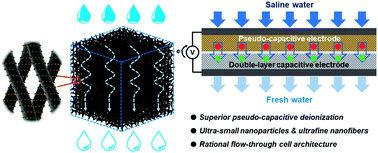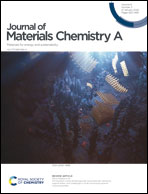MoC nanoparticle-embedded carbon nanofiber aerogels as flow-through electrodes for highly efficient pseudocapacitive deionization†
Abstract
Developing a high-performance capacitive deionization (CDI) system with both high desalination capacity and fast desalination rate is an urgent requirement to solve fresh-water shortage problems. Herein, we report the design of a highly efficient flow-through pseudo-capacitive deionization (FTE-PCDI) system based on the usage of pseudo-capacitive MoC nanoparticle-embedded carbon nanofiber aerogels (MoC@CNFAs) as flow-through electrodes. The as-synthesized MoC@CNFAs, derived from processing molybdate-incorporated natural bacterial cellulose by a simple solid-state reaction, show excellent pseudo-capacitive performance as well as good mechanical strength. Such merits of MoC@CNFAs make them perfect candidates as flow-through electrodes for FTE-PCDI. By integrating the advantages of both the MoC@CNFAs and the flow-through cell architecture into one, the as-fabricated MoC@CNFAs-based FTE-PCDI system exhibits excellent desalination performance (desalination capacity: 37.03 mg g−1; specific energy consumption: 1.61 J mg−1) with an ultra-high desalination rate up to 0.20 mg g−1 s−1, which is significantly higher than that of the existing CDI-related techniques. This study may shed light on the further design of highly efficient CDI systems.



 Please wait while we load your content...
Please wait while we load your content...